Suchergebnisse für "f800 OR desktop OR fume OR extractor OR 80 OR w"
-

Aoyue Ersatz-Filterset für Aoyue 8486 Rauchabsauger
Dieses komplette Ersatzfilterset für den Aoyue 8486 Rauchabsauger enthält einen HEPA-Filter (High Efficiency Particulate Air), einen Baumwoll-Subluftfilter und einen Aktivkohle-Luftfilter.
€ 39,95€ 19,95
Mitglieder identisch
-

Zhongdi ZD-153A Lötrauchabsaugung
Die beim Lötvorgang freigesetzten Dämpfe sind potenziell gesundheitsschädlich. Dieser Lötrauchabsauger wird mit einer Halterung sicher am Arbeitstisch befestigt. Dank der 3 Achsen lässt sich die Lötrauchabsaugung perfekt positionieren, d.h. direkt über den aufsteigenden Lötdämpfen. Die schädlichen Lötdämpfe werden mit einem leistungsstarken, aber leisen Ventilator abgesaugt und durch eine Aktivkohlefiltermatte gefiltert. Features Entfernt Lötrauch Absorbiert giftige Gase und Dämpfe aus Lötarbeiten Verringert das Risiko von Kopfschmerzen, Augenreizungen und Übelkeit Einstellbarer Absorptionswinkel für eine genaue Platzierung Einfach austauschbarer Aktivkohlefilter Hochleistungslüfter Geringe Geräuschentwicklung und lange Lebensdauer Technische Daten Aufnahmekapazität: 1 m³/min (max.) Leistungsaufnahme: 23 W Stromversorgung: 220–240 VAC Menge Aktivkohlefilter: 7 g Maximales Absorptionsgewicht: 2 g Abmessungen: 220 x 270 x 168 mm (B x H x T) Gewicht: 1,4 kg
€ 52,07
-

Voltera Voltera V-One Desktop-Platinendrucker
Lötpastendosierung und Reflow in einem Der Voltera V-One erstellt zweilagige Prototyp-Leiterplatten auf Ihrem Schreibtisch. Gerber-Dateien gehen rein, gedruckte Leiterplatten kommen raus. Der Dispenser trägt eine leitfähige Tinte auf Silberbasis auf und druckt Ihre Schaltung direkt vor Ihren Augen. Die Bestückung traditioneller und additiver Leiterplatten ist mit den Lotpastendosier- und Reflowfunktionen des V-One einfach. Montieren Sie einfach Ihre Platine auf dem Druckbett und importieren Sie Ihre Gerber-Datei in die Voltera-Software. Keine Schablonen mehr erforderlich Die Software von Voltera ist so konzipiert, dass sie leicht zu verstehen ist. Vom Importieren Ihrer Gerber-Dateien bis zum Drücken des Druckknopfes führt Sie die Software sicher durch jeden Schritt. Kompatibel mit EAGLE, Altium, KiCad, Mentor Graphics, Cadence, DipTrace, Upverter. Lieferumfang V-One Platinendrucker V-One Dispenser V-One Sonde Düsenset Spitzenkappen 3 x 4" FR1 Substratset 2 x 3" FR1 Substratset Substratklemmen Rändelschraubenset Hello World Kit Lötdraht Pinzette Netzteil Netzadapter Kabel Benutzerhandbuch Downloads Specifications V-One Software User Manuals Safety Datasheets Technical Datasheets Voltera CAM file for EAGLE Substrates and Templates Mehr Infos Frequently Asked Questions More from the Voltera community Technische Daten Druckspezifikationen Mindestspurbreite 0,2 mm Mindestpassivgröße 1005 Minimaler Pin-zu-Pin-Abstand (leitfähige Tinte) 0,8 mml Mindestabstand zwischen den Pins (Lötpaste) 0,5 mml Widerstand 12 mΩ/sq @ 70 um Höhe Substratmaterial FR4 Max. Plattenstärke 3 mm Lötspezifikationen Lötpastenlegierung Sn42/Bi57.6/Ag0.4 Lötdrahtlegierung SnBiAg1 Lötkolbentemperatur 180-210°C Druckbett Druckbereich 135 x 113,5 mm Max. Heizbetttemperatur 240 °C Rampenrate des beheizten Betts ~2°C/s Abmessungen/Gewicht Abmessungen 390 x 257 x 207 mm (L x W x H) Gewicht 7 kg Systemvoraussetzungen Kompatible Betriebssysteme Windows 7 oder höher, MacOS 10.11 oder höher Kompatibles Dateiformat Gerber Verbindungstyp Kabelgebundenes USB Zertifizierung EN 61326-1:2013 EMC-Anforderungen IEC 61010-1 Sicherheitsanforderungen CE-Kennzeichnung Wird an den Voltera V-One-Druckern angebracht, die an europäische Kunden geliefert werden. Entwickelt und hergestellt in Kanada. Mehr technische Informationen Quickstart Explore Flexible Printed Electronics on the V-One Voltera V-One Capabilities Reel Voltera V-One PCB Printer Walkthrough Unpacking the V-One V-One: Solder Paste Dispensing and Reflow All-in-One Voltera @ Stanford University's Bao Research Group: Robotic Skin and Stretchable Sensors Voltera @ Princeton: The Future of Aerospace Innovation
€ 5.499,00€ 4.949,00
Mitglieder identisch
-

Raspberry Pi Foundation Offizielles Raspberry Pi 4 Desktop Kit (EU)
Dieses „All in One“ Raspberry Pi 4 Desktop Starter Kit enthält alle offiziellen Teile und ermöglicht einen einfachen und schnellen Start! Das Raspberry Pi 4 Desktop Kit enthält: Raspberry Pi US-Tastatur und -Maus 2x Micro-HDMI-auf-Standard-HDMI-Kabel (A/M) 1 m Raspberry Pi 15,3 W USB-C-Netzteil (EU-Version) Gehäuse für Raspberry Pi 4 Offizieller Raspberry Pi-Einsteigerleitfaden (in englischer Sprache) 16 GB NOOBS mit Raspbian microSD-Karte Raspberry Pi 4 B ist NICHT im Lieferumfang enthalten.
€ 64,95€ 32,50
Mitglieder identisch
-
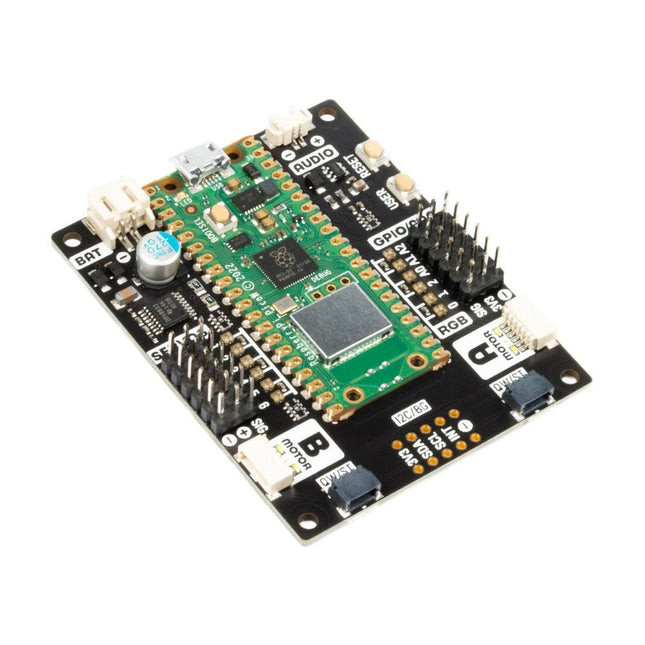
Pimoroni Pimoroni Inventor 2040 W (inkl. Pico W)
Inventor 2040 W ist ein Multitalent-Board, das (fast) alles kann, was Sie von einem Roboter, einer Requisite oder einer anderen mechanischen Sache erwarten. Ein paar schicke Motoren mit angeschlossenen Encodern antreiben? Ja! Bis zu sechs Servos hinzufügen? Sicher? Einen kleinen Lautsprecher anbringen, damit man Lärm machen kann? Kein Problem! Es verfügt außerdem über einen Batterieanschluss, sodass Sie Ihre Erfindungen mit AA/AAA- oder LiPo-Batterien betreiben und Ihren Miniaturautomaten/animierten Zylinder/Schatztruhe, der Ihre Feinde anbrüllt, ungebunden bei sich tragen können. Sie erhalten auch eine Menge Optionen zum Anschließen von Sensoren und anderen Anschlüssen – es gibt zwei Qw/ST-Anschlüsse (und einen unbestückten Breakout Garden-Steckplatz) zum Anbringen von Breakouts, drei ADC-Pins für analoge Sensoren, Fotowiderstände und dergleichen sowie drei zusätzliche digitale GPIOs Könnte für LEDs, Tasten oder digitale Sensoren verwendet werden. Apropos LEDs: Das Board verfügt über 12 adressierbare LEDs (auch Neopixel genannt) – eine für jeden Servo- und GPIO/ADC-Kanal. Merkmale Raspberry Pi Pico W an Bord Dual Arm Cortex M0+ mit bis zu 133 MHz und 264 kB SRAM 2 MB QSPI-Flash mit XiP-Unterstützung Stromversorgung und Programmierung über USB Micro-B 2,4 GHz kabellos 2 JST-SH-Stecker (6-polig) zum Anschließen von Motoren Dual-H-Bridge-Motortreiber (DRV8833) Pro Motorstrombegrenzung (425 mA) LEDs zur Richtungsanzeige je Motor 2-poliger (Picoblade-kompatibler) Anschluss zum Anschließen des Lautsprechers JST-PH-Anschluss (2-polig) zum Anschließen der Batterie (Eingangsspannung 2,5–5,5 V) 6 Sätze Stiftleisten zum Anschluss von 3-poligen Hobby-Servos 6 Sätze Stiftleisten für GPIO (davon 3 ADC-fähig) 12x adressierbare RGB-LEDs/Neopixel Benutzertaste Reset-Knopf 2x Qw/ST-Anschlüsse zum Anbringen von Breakouts Unbefüllte Header zum Hinzufügen eines Breakout Garden-Slots Komplett montiert Kein Löten erforderlich (es sei denn, Sie möchten den Breakout Garden-Steckplatz hinzufügen). C/C++- und MicroPython-Bibliotheken Schematisch Downloads Laden Sie die Piratenmarke MicroPython herunter Erste Schritte mit Raspberry Pi Pico Referenz zur Motorfunktion Servofunktionsreferenz MicroPython-Beispiele C++-Beispiele
€ 44,95€ 22,50
Mitglieder identisch
-
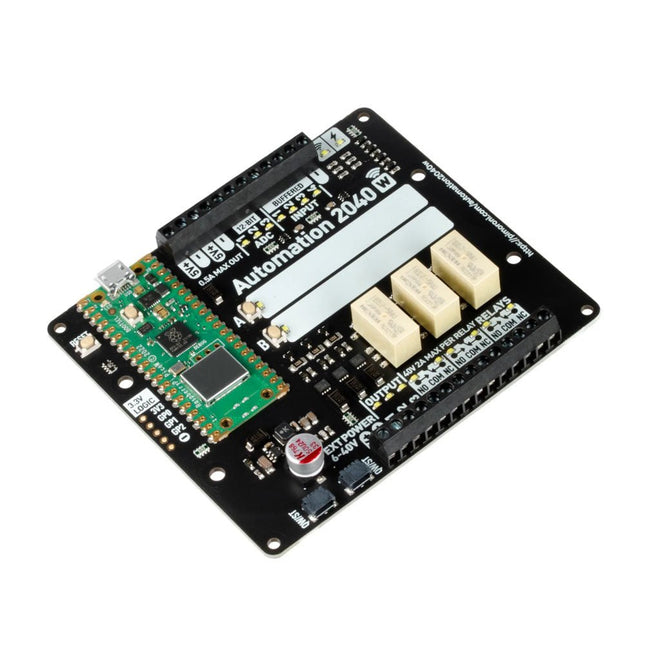
Pimoroni Pimoroni Automation 2040 W (inkl. Pico W)
Ein All-in-One-Industrie-/Automatisierungscontroller mit Pico W, drahtloser 2,46-GHz-Verbindung, Relais und einer Vielzahl von Ein- und Ausgängen. Kompatibel mit 6-V- bis 40-V-Systemen. Automation 2040 W ist eine mit Pico W / RP2040 betriebene Überwachungs- und Automatisierungskarte. Es enthält alle großartigen Funktionen des Automation HAT (Relais, analoge Kanäle, Spannungsausgänge und gepufferte Eingänge), aber jetzt in einer einzigen kompakten Karte und mit einem erweiterten Spannungsbereich, so dass Sie es mit mehr Geräten verwenden können. Ideal für die Steuerung von Lüftern, Pumpen, Magneten, großen Motoren, elektronischen Schlössern oder statischer LED-Beleuchtung (bis zu 40 V). Alle Kanäle (und die Tasten) haben eine zugehörige LED-Anzeige, so dass Sie auf einen Blick sehen können, was mit Ihrem Setup passiert, oder Ihre Programme testen können, ohne dass Hardware angeschlossen ist. Features Raspberry Pi Pico W (inbegriffen) Dual Arm Cortex M0+ mit bis zu 133 MHz und 264 KB SRAM 2 MB QSPI-Flash mit XiP-Unterstützung Stromversorgung und Programmierung über USB Micro-B 2,4-GHz-WLAN 3x 12-Bit-ADC-Eingänge bis zu 40 V 4x digitale Eingänge bis 40 V 3x digitale Sourcing-Ausgänge an V+ (Versorgungsspannung) 4 A max. Dauerstrom 2 A max. Strom bei 500 Hz PWM 3x Relais (NC- und NO-Klemmen) 2 A bis 24 V 1 A bis 40 V 3,5-mm-Schraubklemmen zum Anschluss von Eingängen, Ausgängen und externer Stromversorgung 2 taktile Tasten mit LED-Anzeigen Zurücksetzen-Taste 2x Qw/ST-Anschlüsse zum Anbringen von Breakouts M2,5 Befestigungslöcher Vollständig montiert Kein Löten erforderlich. C/C++ and MicroPython libraries Schematic Dimensional drawing Stromversorgung Das Board ist mit 12-V-, 24-V- und 36-V-Systemen kompatibel Benötigt 6-40 V Versorgung Kann 5 V bis zu 0,5 A für Anwendungen mit niedrigerer Spannung liefern Software Pirate-brand MicroPython Getting Started with Raspberry Pi Pico MicroPython examples MicroPython function reference C++ examples C++ function reference Getting Started with Automation 2040 W
€ 84,95€ 42,50
Mitglieder identisch
-
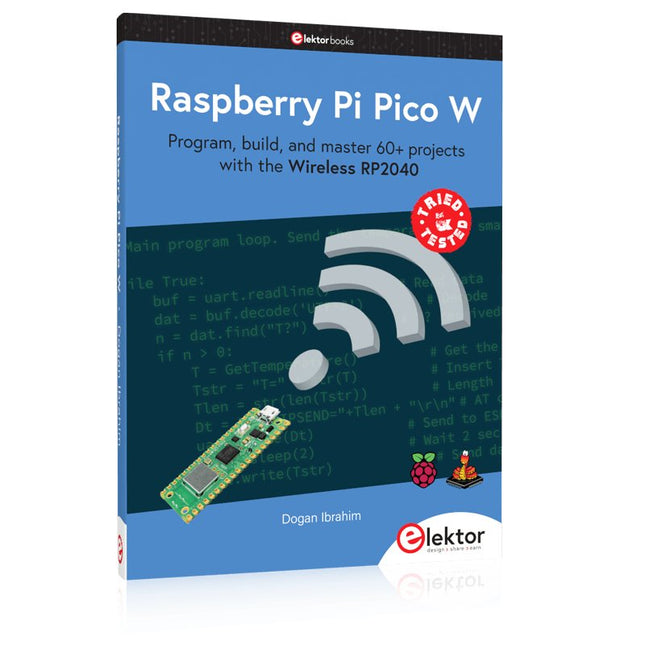
Elektor Publishing Raspberry Pi Pico W (Book)
Program, build, and master 60+ projects with the Wireless RP2040 The Raspberry Pi Pico and Pico W are based on the fast, efficient, and low-cost dual-core ARM Cortex M0+ RP2040 microcontroller chip running at up to 133 MHz and sporting 264 KB of SRAM and 2 MB of Flash memory. Besides spacious memory, the Pico and Pico W offer many GPIO pins, and popular peripheral interface modules like ADC, SPI, I²C, UART, PWM, timing modules, a hardware debug interface, and an internal temperature sensor. The Raspberry Pi Pico W additionally includes an on-board Infineon CYW43439 Bluetooth and Wi-Fi chipset. At the time of writing this book, the Bluetooth firmware was not yet available. Wi-Fi is however fully supported at 2.4 GHz using the 802.11b/g/n protocols. This book is an introduction to using the Raspberry Pi Pico W in conjunction with the MicroPython programming language. The Thonny development environment (IDE) is used in all of the 60+ working and tested projects covering the following topics: Installing the MicroPython on Raspberry Pi Pico using a Raspberry Pi or a PC Timer interrupts and external interrupts Analogue-to-digital converter (ADC) projects Using the internal temperature sensor and external sensor chips Using the internal temperature sensor and external temperature sensor chips Datalogging projects PWM, UART, I²C, and SPI projects Using Bluetooth, WiFi, and apps to communicate with smartphones Digital-to-analogue converter (DAC) projects All projects are tried & tested. They can be implemented on both the Raspberry Pi Pico and Raspberry Pi Pico W, although the Wi-Fi-based subjects will run on the Pico W only. Basic programming and electronics experience are required to follow the projects. Brief descriptions, block diagrams, detailed circuit diagrams, and full MicroPython program listings are given for all projects.
€ 44,95
Mitglieder identisch
-
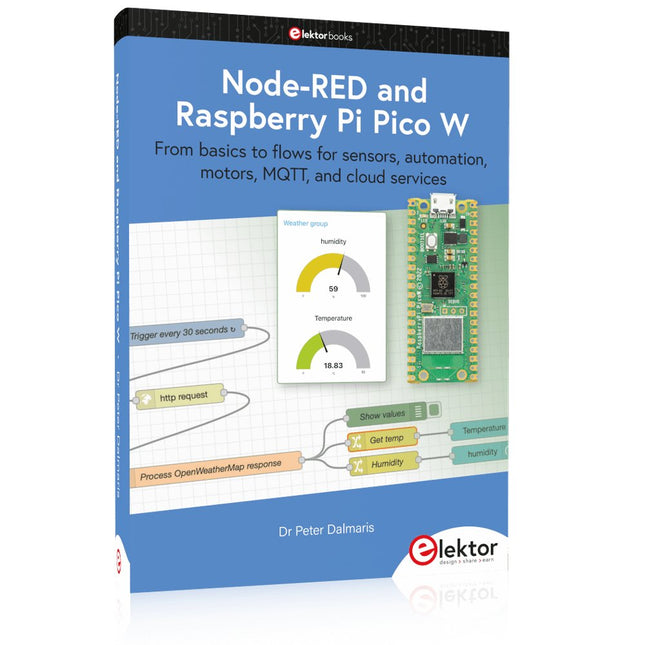
Elektor Publishing Node-RED and Raspberry Pi Pico W
From basics to flows for sensors, automation, motors, MQTT, and cloud services This book is a learning guide and a reference. Use it to learn Node-RED, Raspberry Pi Pico W, and MicroPython, and add these state-of-the-art tools to your technology toolkit. It will introduce you to virtual machines, Docker, and MySQL in support of IoT projects based on Node-RED and the Raspberry Pi Pico W. This book combines several elements into a platform that powers the development of modern Internet of Things applications. These elements are a flow-based server, a WiFi-enabled microcontroller, a high-level programming language, and a deployment technology. Combining these elements gives you the tools you need to create automation systems at any scale. From home automation to industrial automation, this book will help you get started. Node-RED is an open-source flow-based development tool that makes it easy to wire together devices, APIs, and online services. Drag and drop nodes to create a flowchart that turns on your lights at sunset or sends you an email when a sensor detects movement. Raspberry Pi Pico W is a version of the Raspberry Pi Pico with added 802.11n Wi-Fi capability. It is an ideal device for physical computing tasks and an excellent match to the Node-RED. Quick book facts Project-based learning approach. Assumes no prior knowledge of flow-based programming tools. Learn to use essential infrastructure tools in your projects, such as virtual machines, Docker, MySQL and useful web APIs such as Google Sheets and OpenWeatherMap. Dozens of mini-projects supported by photographs, wiring schematics, and source code. Get these from the book GitHub repository. Step-by-step instructions on everything. All experiments are based on the Raspberry Pi Pico W. A Wi-Fi network is required for all projects. Hardware (including the Raspberry Pi Pico W) is available as a kit. Downloads GitHub
€ 49,95
Mitglieder € 44,96
-
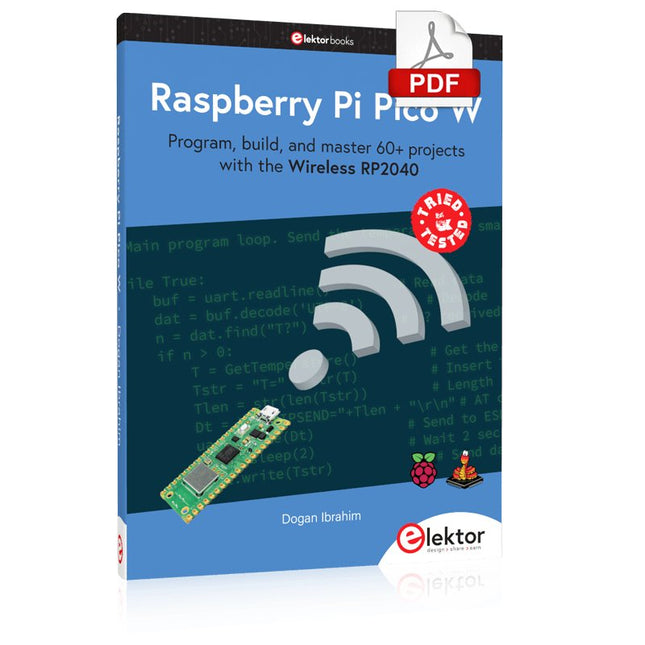
Elektor Digital Raspberry Pi Pico W (E-Book)
Program, build, and master 60+ projects with the Wireless RP2040 The Raspberry Pi Pico and Pico W are based on the fast, efficient, and low-cost dual-core ARM Cortex M0+ RP2040 microcontroller chip running at up to 133 MHz and sporting 264 KB of SRAM and 2 MB of Flash memory. Besides spacious memory, the Pico and Pico W offer many GPIO pins, and popular peripheral interface modules like ADC, SPI, I²C, UART, PWM, timing modules, a hardware debug interface, and an internal temperature sensor. The Raspberry Pi Pico W additionally includes an on-board Infineon CYW43439 Bluetooth and Wi-Fi chipset. At the time of writing this book, the Bluetooth firmware was not yet available. Wi-Fi is however fully supported at 2.4 GHz using the 802.11b/g/n protocols. This book is an introduction to using the Raspberry Pi Pico W in conjunction with the MicroPython programming language. The Thonny development environment (IDE) is used in all of the 60+ working and tested projects covering the following topics: Installing the MicroPython on Raspberry Pi Pico using a Raspberry Pi or a PC Timer interrupts and external interrupts Analogue-to-digital converter (ADC) projects Using the internal temperature sensor and external sensor chips Using the internal temperature sensor and external temperature sensor chips Datalogging projects PWM, UART, I²C, and SPI projects Using Bluetooth, WiFi, and apps to communicate with smartphones Digital-to-analogue converter (DAC) projects All projects are tried & tested. They can be implemented on both the Raspberry Pi Pico and Raspberry Pi Pico W, although the Wi-Fi-based subjects will run on the Pico W only. Basic programming and electronics experience are required to follow the projects. Brief descriptions, block diagrams, detailed circuit diagrams, and full MicroPython program listings are given for all projects.
€ 34,95
Mitglieder € 27,96
-

FNIRSI FNIRSI DPS150 DC-Netzteil (150 W)
Das FNIRSI DPS150 ist ein leistungsstarkes, einstellbares Gleichstromnetzteil, das über eine USB-C-Eingangsschnittstelle und mehrere Stromversorgungsmodi verfügt und eine präzise Einstellung der Ausgangsspannung (0-30 V) und des Ausgangsstroms (0-5 A) ermöglicht. Es bietet einen effizienten, verbrauchsarmen und stabilen Ausgang und ist mit mehreren Sicherheitsschutzfunktionen ausgestattet, darunter Überspannung, Überstrom, Überlastung, Überhitzung und Verpolung. Es kann flexibel für die serielle Verbindung mehrerer Geräte eingesetzt werden, verfügt über eine umfangreiche und benutzerfreundliche Anzeige und Bedienung sowie ein kompaktes und tragbares Design und erfüllt verschiedene Anwendungsanforderungen. Features 30 V, 5 A, 150 W variabler Gleichstrom mit 0,01 V, 0,001 A Präzision, CC/CV-Modi und <20 mV Welligkeit zum Schutz empfindlicher Elektronik. Unterstützt PC-, QC- und DC-Eingänge mit programmierbaren Ausgängen und 6 voreingestellten Spannungs-/Stromeinstellungen. Kompatibel mit 4 mm-Bananensteckern, U-förmigen Anschlüssen und Kupferdrähten für verschiedene Geräte. 8 Sicherheitsmechanismen, einschließlich Überspannungs-, Strom-, Kurzschluss- und Überhitzungsschutz. 2,8" HD-IPS-Bildschirm mit um 90° umklappbarer, numerischer und Kurvenanzeige für einfache Überwachung. Kleines, platzsparendes Design für den Einsatz in Laboren, Reparaturen und Heimwerkerprojekten. Technische Daten Eingangsspannung 5~32 V DC Eingangsstrom 100 mA-5 A Ausgangsspannung 0-30 V Ausgangsstrom 0~5 A Ausgangsleistung 0-150 W Eingabeweg PD-Schnellladegerät QC-Schnellladegerät Powerbank Gleichstromadapter Betriebsumgebung 0-40°C Regulierung laden 0,49% Volllasteffizienz 96,30% Display 2,8 Zoll (320 x 240) Abmessungen 106 x 76 x 28 mm Gewicht 178 g Lieferumfang 1x DPS150 Netzteil 2x Krokodilklemmendrähte (schwarz und rot) 1x Micro-USB-Kabel 1x Manual Downloads Manual Firmware V0.0.1
€ 58,02
-

FNIRSI FNIRSI DPS150PD DC-Netzteil (150 W)
Das FNIRSI DPS150 ist ein leistungsstarkes, einstellbares Gleichstromnetzteil, das über eine USB-C-Eingangsschnittstelle und mehrere Stromversorgungsmodi verfügt und eine präzise Einstellung der Ausgangsspannung (0-30 V) und des Ausgangsstroms (0-5 A) ermöglicht. Es bietet einen effizienten, verbrauchsarmen und stabilen Ausgang und ist mit mehreren Sicherheitsschutzfunktionen ausgestattet, darunter Überspannung, Überstrom, Überlastung, Überhitzung und Verpolung. Es kann flexibel für die serielle Verbindung mehrerer Geräte eingesetzt werden, verfügt über eine umfangreiche und benutzerfreundliche Anzeige und Bedienung sowie ein kompaktes und tragbares Design und erfüllt verschiedene Anwendungsanforderungen. Features 30 V, 5 A, 150 W variabler Gleichstrom mit 0,01 V, 0,001 A Präzision, CC/CV-Modi und <20 mV Welligkeit zum Schutz empfindlicher Elektronik. Unterstützt PC-, QC- und DC-Eingänge mit programmierbaren Ausgängen und 6 voreingestellten Spannungs-/Stromeinstellungen. Kompatibel mit 4 mm-Bananensteckern, U-förmigen Anschlüssen und Kupferdrähten für verschiedene Geräte. 8 Sicherheitsmechanismen, einschließlich Überspannungs-, Strom-, Kurzschluss- und Überhitzungsschutz. 2,8" HD-IPS-Bildschirm mit um 90° umklappbarer, numerischer und Kurvenanzeige für einfache Überwachung. Kleines, platzsparendes Design für den Einsatz in Laboren, Reparaturen und Heimwerkerprojekten. Technische Daten Eingangsspannung 5~32 V DC Eingangsstrom 100 mA-5 A Ausgangsspannung 0-30 V Ausgangsstrom 0~5 A Ausgangsleistung 0-150 W Eingabeweg PD-Schnellladegerät QC-Schnellladegerät Powerbank Gleichstromadapter Betriebsumgebung 0-40°C Regulierung laden 0,49% Volllasteffizienz 96,30% Display 2,8 Zoll (320 x 240) Abmessungen 106 x 76 x 28 mm Gewicht 178 g Lieferumfang 1x DPS150 Netzteil 2x Krokodilklemmendrähte (schwarz und rot) 1x C2C PD Ladekabel 1x 100 W PD GaN Adapter (EU) 1x Micro-USB-Kabel 1x Manual Downloads Manual Firmware V0.0.1
€ 93,43
-

, von Clemens Valens Review: Die Desktop-CNC- und Graviermaschine Anet 4540
Wie 3D-Drucker und Lasergraviermaschinen haben auch CNC-Maschinen sich inzwischen etabliert. Während sie früher Tausende von Euro gekostet haben, sind heute CNC-Maschinen der Einstiegsklasse wie die...











